- 3 Easy, Reliable, Productive Cut Flowers: Sunflowers, Zinnias & Rudbeckia
- 5 Factors That Determine Vase Life of Cut Flowers
- 2019 American Flowers Week: Combining the Art of Floral Design & Couture
- Celebrate the 7th American Flowers Week | Johnny's 2021 Botanical Couture
- Celebrating the 8th American Flowers Week | Johnny's 2022 Botanical Couture
- Collective Selling Models for Flower Farmers: Flower Hubs That Work
- 5 Cool Flowers to Plant Now | Lisa Mason Ziegler's Secrets for Growing Hardy, Cool-Season Annuals
- Cut-Flower Harvesting & Post-Harvest Care | Best Practices from Pros in the Slow Flower Community
- Cut-Flower Kit | Guide for Market Growers (PDF)
- Easy Cut-Flower Garden Map | For Growers New to Flowers (PDF)
- Easy Cut-Flower Garden Planner | For Growers New to Flowers (PDF)
- From Color to Climate: 5 Floricultural Trends Subtle & Seismic
- Flower Culture by Crop | Comparison Chart | Days to Germination, Weeks to Transplant, Days to Harvest (PDF)
- Flower Farmers' Favorite Fillers & Foliage | Recommendations from 3 Farmer-Florists
- Getting Started in Cut-Flowers | Top 15 Cuts
- Heat & Drought: How Flower Farmers Are Adapting to Changing & Challenging Climatic Conditions
- Introduction to Overwintering Flowers | Guide to Overwintering Flowers
- An Introduction to Producer Marketing Cooperatives | M Lund & Associates
- How Day Length Affects Cut-Flower Production
- Growing Flowers in Hoophouses & High Tunnels: Cool-Weather & Hot-Weather Options
- Starting a U-Pick Flower Farm, From A-to-Z
- Growing Flower Seedlings for Profit
- Roadside Flower Stand Basics: Success Tips for On-Farm Retail
- Year-Round Flower Production Strategy
- Overwinter Flower Trials | Multiyear Results for 30+ Crops | Johnny's Selected Seeds | XLSX
- Seeding Date Calculator | Johnny's Recommended Flowers for Overwintering | XLSX
- Pricing & Profitability for Flower-Farmers | Pointers from a Diversity of Pros
- Sustainable Farming Methods | A Survey of Flower Farmers' Best Practices
- Just Add Flowers | An Introduction to Companion Planting for Vegetable & Herb Gardeners
- Slow Flowers Palette & Petal Crushes | Evolving Colors & Shape-Shifts in Floral Industry Trends
- Johnny's and Slow Flowers | Johnny's Selected Seeds
- Slow Flowers | Celebrating Fifth-Season Regional Design Elements
- Slow Flowers Floral Forecast | A Summary of Industry Insights & Trends
- Building a Better Market Bouquet: Tips, Techniques & Recipes for Flower Farmers
- Slow Flowers | Tips for Staging On-Farm Floral Workshops | Johnny's Selected Seeds
- Wedding Wisdom 101 | 10 Beginner Tips for Entering the Wedding Floral Landscape
- Succession-Planting Flowers | Scheduling & Planning, Sowing Frequency, Recordkeeping & Recommendations
- Succession-Planting Interval Chart for Flowers
- Sustainable Floral Design | Techniques & Mechanics for Foam-Free Floristry | Tobey Nelson & Debra Prinzing
- Video: Mason Jar Bouquet Tutorial
- Video: How to Build a Bouquet
- Video: Tobey Nelson | Sustainable Floral Design | Slow Flowers Summit
- Video: Economic Considerations in Overwintering Cut Flowers | Johnny's Selected Seeds
- Top 10 Cut-Flower Varieties for Direct Seeding
- Video: Floating Row Cover | Baby "Cool Flower" Protection from Whipping Winter Winds
- Video: The Procona System for All-in-one Flower Harvest, Transport & Display
- Johnny's Overwinter Flowers Tunnel: Trellising, Supports, Ground Cover & Spacing
- Video: Irrigation Considerations for the Overwinter Flowers Tunnel | Johnny's Selected Seeds
- Video: Johnny's Overwinter Flowers Trial Recap
- Video: Producer Cooperatives for Small-Scale Farmers | Johnny's Webinar Series
- Climate Adaptation for Vegetable & Flower Farmers | Johnny's Educational Webinar Resources
- Chrysal CVBN Flower Conditioner | SDS
- Webinar Slide Deck | New-for-2023 Flowers & Floral Supplies | PDF
- Chrysal Clear Bulb Flower Conditioner | SDS
- Chrysal Professional 2 Transport & Display T-Bag | SDS
- Chrysal Classic Professional 2 Transport & Display (Holding) Solution | SDS
- Chrysal Clear Universal Flower Conditioner | SDS
- Webinar Slide Deck | Flower Growing in Southern States | PDF
- Choosing Flower Crops to Overwinter | Guide to Overwintering Flowers
- Edible Flowers List: Top 20 Favorites from the Slow Flowers Community
- Floral Standards for Flower Farm Collectives and Cooperatives
- Bloom to Boom: Flower Farm Profitability
- Choosing Tulip Varieties for Forcing | Guide to Forcing Flower Bulbs
- Forcing Tulip Bulbs | Guide to Forcing Flower Bulbs
- Snapdragon Groups Explained
- Flowering in the South: Profiles of 5 flower farmers who cope with temperature, humidity, pest & weed pressure
- Video: Flower Growing in Southern States | Johnny's Webinar Series
- 10 Tips for Building a Profitable Cut-Flower Business
- Introduction to Forcing Flower Bulbs in Soil | Guide to Forcing Flower Bulbs
- U-Pick Power for Your Flower Farm | Johnny's Webinar Series
- Eat Your Flowers: Serve Up That Wow Factor With Edible Flowers
- U-Pick Power for Your Flower Farm | Johnny's Webinar Series
- Flower Growing in Southern States | Johnny's Educational Webinar Series
- Chrysal Clear Bulb T-Bag | Cut-Flower Conditioner | SDS
- Chrysal Professional 1 Hydration Solution | SDS
- Chrysal Professional 3 Vase Solution Powder | SDS
- When to Start Seeds for Overwintered Flowers | Guide to Overwintering Flowers
- Webinar Slide Deck | U-Pick Power for Your Flower Farm | PDF
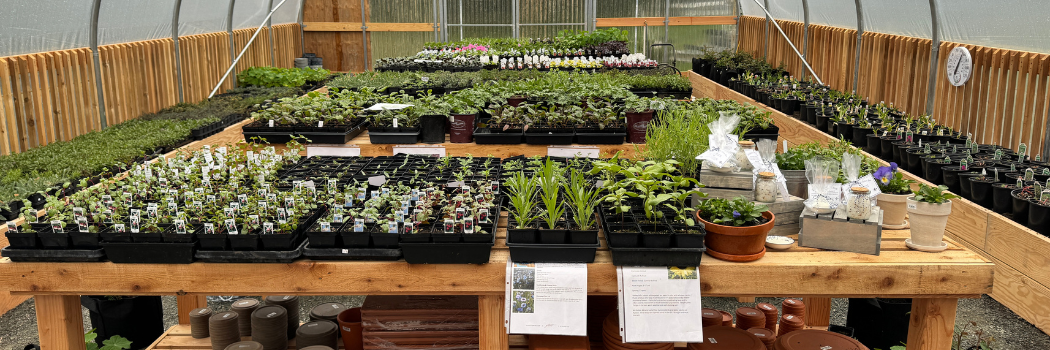
Growing Flower Seedlings for Profit
By Debra Prinzing, Slow Flowers Society, November 2025
Translate your expertise into a revenue stream when you grow and sell cutting garden plants to flower lovers and fellow growers.
In the 2022 Slow Flowers Floral Insights and Industry Forecast, we featured “Plant Your Bouquet,” as both an emerging gardening trend and a business opportunity for flower farmers.
My eyes were opened to this concept several years ago when some of the Seattle Wholesale Growers Market farmers brought in extra 4-inch pots of their sweet pea starts. Yes, I purchased many of the uncommon sweet peas from Everyday Flowers’ Vivian Larson, but I also witnessed her extra seedlings in the carts of florists and aspiring flower farmers who shopped at the market. The plants were snatched up at $7 each.
The idea of “gardening like a flower farmer” has taken off as increasingly, home gardeners and floral enthusiasts are asking for the unique cultivars that pros grow. And although demand for flower seeds continues to rise, many gardeners want to jump-start their cutting gardens with flowers sown by someone else, perhaps due to time and space constraints.
Anyone who has shopped at a retail nursery might understand why. Garden centers merchandise with plants that are already flowering—that big-bloom-eye-candy certainly provides instant gratification. But that’s not optimal for the cut flower garden. Flower lovers who dream of having a lush, colorful cutting garden, need to plant young starts and grow them over a season to harvest time.
Nearly four years after publishing the “Plant Your Bouquet” insight, we have more examples of the “cut flower garden” moving into backyard veggie patches. We are seeing florists and new flower farmers eager to connect with experienced growers who are selling curated collections of starts or seedlings.
A few years ago, we surveyed Slow Flowers members and asked: “How are you diversifying floral offerings to customers?” The results, while only a snapshot of a moment in time, are revealing. Respondents were asked to choose all of the options that applied to them:
There are many examples of how to turn flower farming know-how into new channels of business and this article will share models and advice from several expert Slow Flowers members:
- Sarah Buerkley, Sarah’s Cottage Creations (Stillwater, MN)
- Celeste Monke, Free Range Flowers (Bellingham, WA)
- Fawn Rueckert, Sego Lily Flower Farm and Snuck Farm (Salt Lake City area, UT)
- Kate Skelton, Gratitude Flowers (Edgewood, WA)
- Carol Wetzel and Allan Tone, The Little Farm on Olga Road (Orcas Island, WA)
What expertise do you have that customers want?

Gratitude Flowers has eliminated six-pack plastic trays and sells only in soil blocks. Photo © Gratitude Flowers.
This is the first question you should answer for yourself. Customers may want to get their hands on hard-to-find seeds, or learn a new skill, such as soil-blocking or designing planting schemes.
Flower farming expertise is gained over time, through sweat equity and hands-on experience. This body of knowledge is something you can market as a service or product to flower lovers.
Package your expertise in crop planning, seed selection and garden design. It's smart business to empower your customers to grow anything—it will make them appreciate your farming talents even more. Whether you develop a scalable planting plan for customers (by theme, season or palette) or sell the plants and seedlings as a new product offering, there is no downside to teaching someone to appreciate growing their own flowers. In doing so, you'll unlock a new passion and expand the awareness of local and seasonal flowers in your marketplace.
Variety Selection: What flower varieties do customers want to plant?
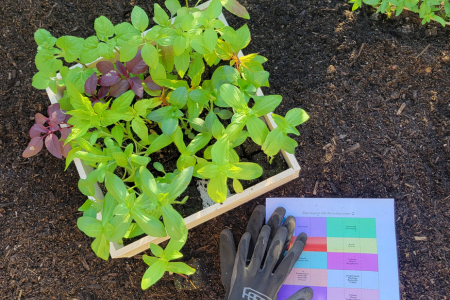
Gratitude Flowers offers a Bloom Box—a curated collection of seedlings customers can use to grow their own cutting garden.
Photo © Gratitude Flowers.
Bottom line, the home gardener wants to grow those lavish, dreamy blooms they see on flower farmers’ Instagram and Pinterest feeds. It’s floral fantasy without the grit and grind of farming, for sure, but growing cut flowers to sell at retail pricing means you’re trading your time and knowledge for a new revenue stream. Across the board, the people interviewed here suggest you grow floral varieties that have a perceived added value. Starting with annuals, this means flowers that are vigorous and long-stemmed, with unique forms and/or popular petal colors.
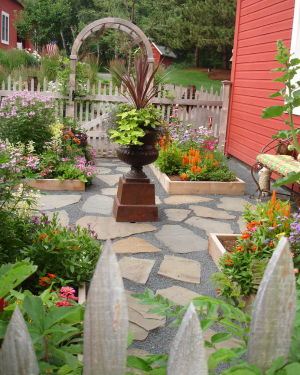
Sarah of Sarah's Cottage Creations is often reminded that while clients want beautiful gardens from which they can cut, they don’t intend to become flower farmers. Photo © Sarah's Cottage Creations.
Sarah of Sarah's Cottage Creations is often reminded that while clients want beautiful gardens from which they can cut, they don’t intend to become flower farmers. “I keep it simple. I like to start people off with the easiest flowers—zinnias, cosmos, rudbeckia, cornflowers. We don’t want to frustrate them or they won’t want to continue growing flowers. For someone new, these are amazing options that make people feel like they’re successful. We also love the idea of helping them add flowers like dahlias to the vegetable garden. It gives them another chance to cut and bring stems indoors. This also includes teaching them to use vegetables or herbs in their arrangements—rosemary or basil that can be both edible and ornamental.”
For Kate Skelton of Gratitude Flowers, lisianthus is a top crop. “I hear from people all the time that if they grow lisianthus from seed, their backyard greenhouse may be occupied for six months and they can’t grow anything else.” Licensed in Washington state as a nursery seller (which is required of any business selling more than $100 of plant material each year), Kate originally started Gratitude Flowers to grow starts for small flower farms and to inspire backyard gardeners to plant more blooms. “I’m usually selling to newer farmers and gardeners who want to buy their starts locally, or they don’t have the buying power to order quantities of plugs and pay for the shipping.”
Her year begins with cool season annuals for spring, followed by warm season ones for summer. At her opening season sale, usually held the first weekend in April, Kate offers more than 50 flower varieties in soil blocks. “I have eliminated six-pack plastic trays and now I am trying to sell only soil blocks,” she notes. “Since I want to move the soil-blocked seedlings, I offer quantity discounts. If my 2-inch blocks don’t sell, I transfer them to 4-inch pots after a few weeks.”
In addition to designing and growing curated cut flower collections, Fawn Rueckert (Sego Lily Flower Farm and Snuck Farm ) also grows about 50 varieties—from lisianthus, snapdragons, ranunculus and anemones to full, 72-plant flats of 'Benary's Giant Mix' zinnias. At the April plant sale, these options are likely to sell out. “I keep doubling and tripling how much I grow! Because of all the pre-orders, I wondered if we would sell any lisianthus flats this year. I tripled what I had grown the year before and we sold out in five minutes. We had people lined up the street.”
Last year, Fawn introduced perennials and she’s been surprised by the appetite gardeners have for ladies’ mantle, rudbeckia, Silene ‘Blushing Lanterns’, and echinacea, among others. “We concentrate on a lot of those first-year flowering perennials. People want the three-foot-tall varieties that flower farmers grow; not the 12-inch ones they see at their nursery. So I’m just giving them what the farmers grow, plants they can’t find elsewhere.”
Curated Seedling Collections

At The Little Farm on Olga Road, customers can choose from a pre-designed "Garden to Go" collection or they can personalize their plant mix. Photo © The Little Farm on Olga Road.
Several interviewees sell curated collections of seedlings. Now in her fifth season, Kate of Gratitude Gardens has developed repeat business with her “Gratitude Bloom Box,” which are upcycled wood crates that originally contained four wine bottles from Costco (friends and family members save them for Kate). Each holds 36 2-inch soil block seedlings for planting a cutting garden. Kate sold her early spring Bloom Box for $85 (it included 19 annuals and 7 perennials—12 varieties in all). In the summer, her all-annual Bloom Box sells for $75. “My idea of a curated collection is appealing because I’m selecting flowers that are popular in floral arrangements,” she notes.
The Little Farm on Olga Road offers a "Garden to Go” collection that includes a set of six 4-inch pots, ranging from heirloom perennials to medicinal herbs. In addition to choosing a pre-designed plant collection, buyers can also personalize their plant mix. “In our display gardens, they can see what a plant will ultimately look like, what type of spacing we recommend, and what they might want to combine in their own six-pack of plants,” Carol explains.
As Snuck’s Cut Flower Director, Fawn Rueckert and a small team of seasonal staff grow for two sales channels. “We sell wholesale to people with a resale license (both new and established farms), and then we have our curated collections that our backyard growers can buy.” Growing plants to sell to retail customers has been a huge success for this venture, with retail sales outpacing wholesale sales for the first time in 2024, Fawn says. “People can buy collections or they can take a class and learn how to do it themselves.”
On-Farm Education & Training

At The Little Farm on Olga Road, customers are encouraged to meander the gardens; part of the education is showing people that combining flowers and vegetables creates an ecosystem for beneficial insects. Photo © The Little Farm on Olga Road.
At The Little Farm on Olga Road, Carol Wetzel and Allan Tone run a hybrid business that includes on-farm events, workshops and tours; a flower, herb, and vegetable u-pick program; and the popular "Garden to Go” box packed with plants that customers can use to start their own backyard flower garden. Their farm stand also stocks bouquets, plants, pots, eggs, cards, t-shirts, candles, and products in a tallow-based skincare line.
They consider The Little Farm an incubator of ideas, encouraging visitors to take home concepts that suit their gardening lifestyle. “We want to inspire them to plant a small plot in their garden, or transform their entire yard (which is what we ultimately did) and turn it into a space where they can grow cut flowers, dabble in bouquet-making, or interplant vegetables that they want to cook with and eat,” Carol explains. “We encourage people to meander through the gardens here to collect their vegetables, pick from a fruit tree, and cut flowers to make a bouquet. Part of the education here is also showing people that flowers plus vegetables creates an ecosystem for beneficial bugs.”
The Little Farm’s message of sustainability resonates with both Orcas Island residents (the year-round population is around 5,000) and tourists who flock to the popular vacation destination. “I don’t think what we do is very common,” Allan points out. “We invite people onto our farm to explore it all. They take selfies or photos of flowers they haven’t seen. Our three French bulldogs are here to welcome them.”
Set amid the serene Orcas Island landscape that attracts visitors who want to blend nature and learning, The Little Farm invites their guests to slow down and engage their senses. They wander through the garden beds and take note of information (via QR code signage posted on bird-perch stakes) with stories about specific plants, including growing tips. This spring, Carol will draw from her doctorate in adult learning as an accomplished educator and offer a four-day immersive course on Market Gardening. “I designed the course for curious gardeners, aspiring entrepreneurs, and culinary aficionados,” she says. “Participants will gain the knowledge to cultivate their own productive gardens and leave inspired to grow and share their bounty.” Since her farm is located across from an established inn and restaurant, she envisions that housing and meals can be folded into the course.
What skills do customers want to learn?
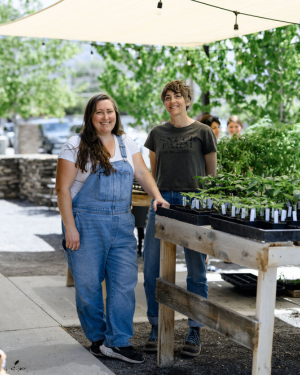
Snuck Farm offers a "Backyard Cut Flower Garden Course" which covers everything from growing to bouquet-making.
Photo © Snuck Farm.
In 2021, Salt Lake City-based grower Fawn Rueckert, owner of Sego Lily Flower Farm, was hired by Snuck Farm to run its nursery program, after she first taught a flower-growing class there in 2019. “They are a hydroponic farm with a farm shop that sells greens, basil, pesto, and ready-to-eat salads. They also have a few plots of outdoor land where I grow flowers that we harvest for bouquets sold in the farm shop,” she explains.
Fawn runs the "Backyard Cut Flower Garden Course" which will continue for its seventh season next April. According to Fawn, the course is capped at 20 people per year and more than 115 people have taken the course since it began. Many are repeat students and others return to shop for Snuck Farm’s flower starts. “The course idea came from Page Westover, the founder of Snuck Farm,” Fawn says.
“They had run an earlier flower-growing class and when Page sat through part of it, she thought, ‘wow, this is like watching people drink from a firehose!’ She realized that it needed to be a longer course.”
Snuck Farm gave Fawn a plot of land once devoted to vegetable-growing, as well as use of a greenhouse. “I’ve slowly taken it over,” she admits. “It’s been renamed ‘the flower house,’ and now I have the entire space!”
Each student is given a small growing plot of their own, meeting with Fawn every two weeks, from April to October. “We start with irrigation; we cover pest management. Students learn how and when to pinch back. We cover filler choices, like basil options,” she says. “Recently, we took out some of the landscaping to create a perennial space so students can be educated about those cut flower options.” The course also includes dahlia-growing, including a dig and divide tuber session. There’s also an arranging night and a bouquet-making night, and people take buckets of flowers home with them to continue experimenting with their newfound skills.
When a student asked whether Snuck Farm could start cutting garden plants for purchase, it prompted what has become the farm’s robust retail plant program. “There are so many people who don’t have the time or space to start seeds, but they want to grow cut flowers,” Fawn pointed out. She manages the program nearly full-time between February and early May, meaning she has had to make adjustments to what happens at Sego Lily Flower Farm, her one-third-acre micro farm. “I actually treat Sego Lily as an incubator for what we do at Snuck Farm. I plant unusual varieties to see if they are appropriate for the retail or wholesale customer.”
What are future business opportunities?
Flower farmers who are growing cutting garden plants for other farmers and home gardeners, teaching how-to-grow-cut-flower classes, or offering cutting garden design services say they’ve had a taste of the potential for building up the nursery side of their businesses.
For Gratitude Flowers, expanding her nursery to include a larger selection of perennials and aiming for an equal percentage of annual and perennial sales is a goal. “Perennials obviously command more money,” Kate points out. She maintains a mailing list for retail customers who shop Gratitude Flowers’ regularly scheduled pop-up sales (usually held in Kate’s huge driveway) or who come by appointment. “The rest of my outreach is advertising through local Facebook groups. Retail customers find and follow me on social media or via my newsletter.”
While she custom-grows for individual farmers, Kate has been moving to mostly retail pricing. “It’s not cost-effective for me to offer wholesale pricing, because I’m growing part-time. I’m selling mostly to newer flower farmers who really want to buy local. For them, buying in small quantities and not paying shipping is still a value for their farms.”
Fawn provides consulting services through Sego Lily Flower Farm, and she finds that no matter where a flower farmer is based, they face similar challenges. “It’s important to remember that like any other product, people want quality,” she advises. “If you sell ill-harvested cut flowers and they don’t last long, the customer is not coming back. So you want to make sure that you’re growing with the best practices in mind, producing high-quality, healthy plants, and setting up the customer for success.”
Connections through flowers and plants lay the groundwork for community, Fawn adds. “When I first started, I don’t think I understood that. Now, I see these friends at plant sales and it fills my bucket, because I’m talking with people, hugging flower friends and answering their questions—it’s just so fun.”
Case Study: Slow Flowers’ Ultimate Cutting Garden Plant Sale

Slow Flowers members hosted what will be an annual Ultimate Cutting Garden Plant Sale annually, located at the Seattle Wholesale Growers Market. Photo © Debra Prinzing.
In the Seattle area, an organic gardening nonprofit has for years produced an annual Edible Plant Sale each spring. It is hugely popular and typical to see throngs of shoppers lined up to enter the gates. But I always felt there was a missed opportunity to feature cut flowers along with tomato starts and herbs.
Inspired to bring more cut flowers to the gardening community, I approached the Seattle Wholesale Growers Market in early 2025 to propose hosting a cut flower plant sale in their parking lot. After their landlord gave the go-ahead, we kicked off planning for the Ultimate Cutting Garden Plant Sale.
The event took place on the first Sunday in May (one week prior to Mother’s Day, on a different weekend from that famous Edible Plant Sale). We invited local Slow Flowers members to vend along with Growers Market farms. Growers brought cut flower starts, annual seedlings, perennials, flower seeds, bulbs and tubers. We kept the booth pricing at $100 for a 10-by-10-foot space, and gave Slow Flowers Members a booth discount of $50.
Local farmers and growers were only invited about six weeks prior to the sale, which was a challenge. In the future, we’ll notify them at the first of the year. Celeste Monke, of Free Range Flowers, who is a member of both Slow Flowers and Seattle Wholesale Growers Market, brought along Miranda Bowman of Wildrye Farm, a fellow grower, to share her stall. “The two of us have produced an annual plant sale a few times,” Celeste explains. “But getting people to travel to where our farms are located, outside of Bellingham, Washington, was hard. I found the Slow Flowers sale to be significantly more profitable for us.” Having a centralized urban location was key to turnout, she noted.
The sale had a few garden product sponsors and was promoted mostly through our newsletter, local email list, and social media. There is so much interest in cut flower gardening in Seattle that the mix of shoppers included both enthusiastic gardeners and beginning cut flower growers.
“That’s the best sale I ever had,” Kate Skelton raved. “I was sold out in practically 20 minutes.”
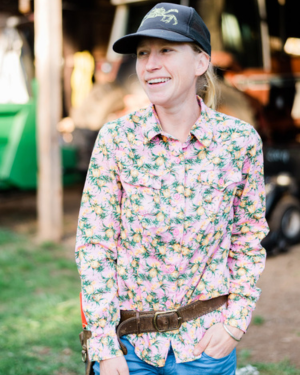
Celeste Monke of Free Range Flowers prepared for the seedling sale by growing quick turnaround annuals like gomphrena and specialty pansies. Photo © Free Range Flowers.
Celeste says she prepped for the sale by “growing annuals with a quick turnaround time, like gomphrena.” She sold 6-packs of specialty pansies ($7 per pack), flats of warm-season annuals, dahlia tubers, and one-gallon perennials like Geum. Among other items, Miranda brought heirloom mum starts, for which she is well known.
“What was surprising to me is that people were buying full flats of cosmos or some of the specialty varieties, like Johnny’s ‘Zinderella Peach’ zinnias—items they perhaps couldn’t get started at home, due to space or infrastructure,” Celeste says. “It was a symbiotic situation and really nice for us to grow for a community beyond ourselves.”
Katy Beene, the Growers Market’s Senior Operations Manager, describes the Ultimate Cutting Garden Plant Sale as a resounding success. The sale took place when the Market was open on Sundays during a trial period, only to the trade. “So this was a bit of an exception, because we allowed the public to shop the cooler for flowers during the plant sale,” she explains. “It definitely opened our eyes to realize that if we decide to open Sunday hours again in the future, the public component needs to be included. Far and away, we had so many public customers that day—and sales were four times what we had on other Sundays. We had all the cash registers running with a line of four people at each. It was a total shot in the arm right before Mother’s Day.”
Cutting Garden Plant Sale Tips:
- Check your state for nursery license requirements and check with your insurance provider to make sure you are adequately covered for a public plant sale.
- Have photographs of the flowers you’re selling, either on a large display or on point-of-purchase tags. “Labeling is still a pinch-point for us,” Celeste observes. “Investing in some kind of label maker or stick-tag printer would be ideal, and necessary if we are going to scale up our plant selling.”
- Keep pricing simple and consistent, especially if you are selling with a group of other growers. There’s been further discussion of standardizing pot sizes by annuals or perennials, especially to make it easy for buyers and people working at the check-out counter.
- Focus on easy-to sow seed crops or divisions from perennials you already have. “I love propagation, and I think if you can use your own plant material (to generate inventory), it really makes sense,” Celeste notes. “Otherwise, you might be buying in costly perennials and potting them up without guarantee of sale.”
- Provide boxes for shoppers. Even though promotions for the Ultimate Cutting Garden Plant Sale encouraged shoppers to bring their own wagons, carts, and boxes, many folks forgot and needed a way to transport their purchases.



